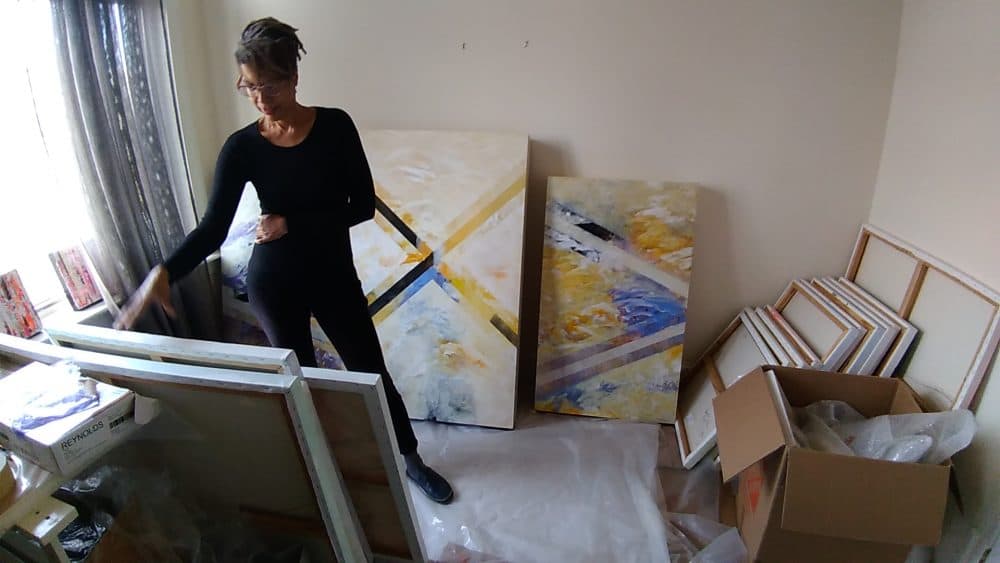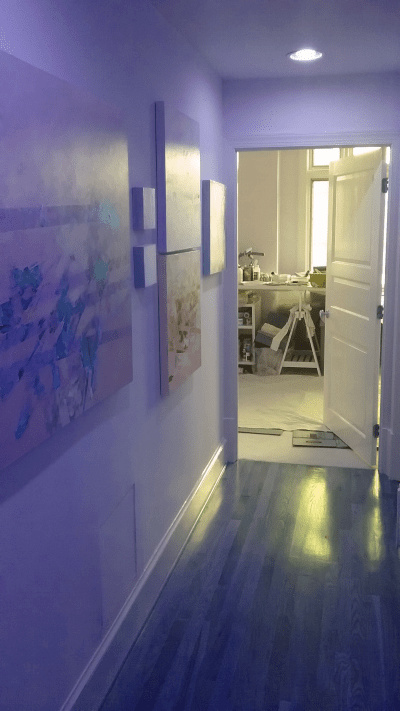Advertisement
Commentary
An Artist’s Dilemma: What To Do With All The Canvases

There’s a dirty little secret among artists. It can be summed up this way: We create art. Our art does not sell. We stuff the art in our closets.
Before long, our closets are filled, so we turn to storage bins. Those fill up quickly too, so we resort to corners of our studios. If our studios aren’t large enough, we cart our paintings and our objets d'art to our homes where they quickly occupy every surface, both horizontal and vertical. Pretty soon, we are buried.
We learn inventive ways to handle art overload. We begin working smaller. We switch from canvas to paper. We move from sculpture to painting, from painting to drawing, from drawing to photography.
Others, like me, reach a crisis point. I am a fairly prolific painter with boxes of paintings wedged tight just about anywhere you might look, but I must decide what to do with my art before the camera crew of “Hoarders” comes knocking at my studio door.
Should I recycle all my older work by painting over old canvases? Destroy all my old canvases altogether? Give them away? (And hey, wait a moment, how can I sell paintings and give them away at the same time?) Then, I wrestle with even greater existential questions. Should I even be producing new work at all, given the state of our planet? Somehow, it seems irresponsible to be adding more things, no matter how beautiful, to a world in which giant garbage patches drift aimlessly around our oceans. I pride myself on many things when it comes to my carbon footprint. I don’t eat meat. I don’t own a car. But here I am with my carbon shoe size growing larger every time I order more art supplies from Dick Blick.
I don’t eat meat. I don’t own a car. But here I am with my carbon shoe size growing larger every time I order more art supplies from Dick Blick.
Boston-based artist John Vinton has confronted this problem and found a solution. First, it must be said, Vinton is one of the lucky ones. He paints about 15 to 20 canvases a year and sells, he estimates, about 80 percent of them. But, as all artists know, there is one big caveat.
“It’s very inconsistent,” he admits. “And it does create a problem with some pieces. My preferred solution is to make room by taking canvases off stretchers and rolling them. But on some of my pieces where the paint is really built up, I’m a little concerned about doing that, because the paint could crack.”
That means, like the rest of us, Vinton gets stuck with artistic build-up. Although he loves to work large on imposing canvases that might span 5 or 6 feet across (and he would work even larger if he had the space for it), he has allowed his artistic expression to cede to cold, hard practicalities.
“I do like working large, but I’ve sort of gotten myself more into working at a smaller scale because they’re easier to store,” says Vinton. “You can do a whole bunch of small ones, and if they don’t sell, it’s not that big of a deal.”
This month, he moved into a smaller studio in the same building, so the problem is likely to become more acute.
Artist Fernando DeOliveira, who also works in Boston, paints between 35 to 50 canvases a year. He says that most of the time, he feels that he doesn’t have enough inventory to allow him to participate in all the shows in all the venues that he would like. Even so, every now and then, he too must grapple with inventory overload. When that happens he says, “I slow down my production. I paint less.”
When he runs out of space, he, like Vinton, removes canvases from stretcher bars and rolls them up for storage under the bed of his guest bedroom in his South Boston condo.
He also shifts his attention toward more aggressive marketing. He admonishes me that this is certainly my problem.

“You can only be a successful commercial artist if you can manage your time,” he reproves me. “You must have time to promote your work, talk to clients, galleries, etc., and have time to paint. If you’re painting in the gallery and you have a pile of work that you’re not selling, and you ask why, it’s because you did not spend enough time promoting your work.”
My problem is certainly not unique in the art world, although I may be the only one talking so openly about it. Managing inventory is a problem that has always plagued artists, including the prolific artist Fay Chandler, who died in 2015 at the age of 92. Chandler had a long and storied career painting whimsical, colorful paintings with an ethereal, illustrative quality. She was the creator of the official First Night Button in 2012. I talked to her a few years before her death about her inventive solution to the artist’s grand problem.
“I wasn't selling anything,” she told me back in 2011. “The galleries said I was too old. When they saw my work, they said it was old hat.”
Chandler made a bold decision. She would give it all away. She became the founder of The Art Connection, which has, since 1995, placed more than 7,660 original works of art by 464 artists in more than 400 art-starved charitable organizations and nonprofits ranging from Rosie's Place to the New England Shelter for Homeless Veterans to the Codman Square Health Center. The Art Connection represented Chandler's brilliantly elegant solution to a common art problem while consolidating her own standing in the art community. Needless to say, after talking to Chandler, I joined the organization myself.
But my placement of paintings with The Art Connection (I’ve placed about a half dozen large paintings through the organization) still cannot keep pace with my production. This means that I, like DeOliveira, have made a conscious choice in the last couple of years to slow down and paint more mindfully. Some have suggested I go digital, which eliminates my concerns about using up the earth’s resources, while also freeing up my closet space. But as a writer who spends half of my life with my eyes fixed on a computer screen, I refuse.
“That just doesn’t work for me,” agrees Vinton. “It’s the immediacy of the paint I really enjoy. The paint is almost as important as what it comes together to create. Without that it just wouldn’t make sense.”
My sentiments exactly. And that means that, unless I get better at marketing, I’ll just have to put up with the common artistic problem of inventory overload.
I keep in mind what DeOliviera has told me.
"My canvases might be taking up space under my bed, but one day, someone’s going to find them. And every time someone looks at them, they’re going to smile."
Fernando DeOliveira
“My canvases might be taking up space under my bed, but one day, someone’s going to find them,” he says. “And every time someone looks at them, they’re going to smile. They’re going to say, ‘Oh, my god, this so beautiful.’ ”
Until then, I’ll be looking into the price of storage pods.
